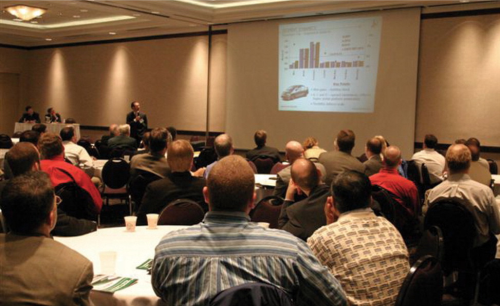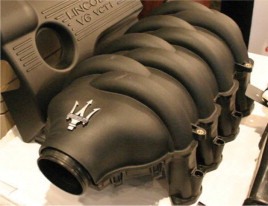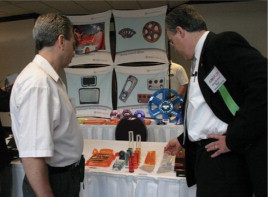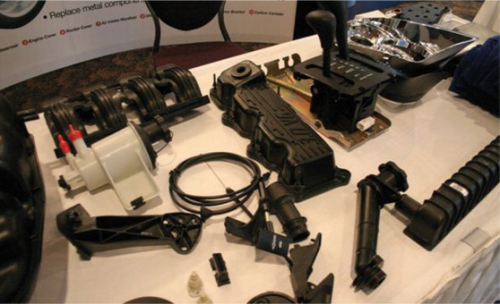



The second annual SPE Automotive Engineering Plastics Conference was off to a good start: one day, 24 April 2007, crammed with displays, networking, keynote addresses, and presentations for 227 attendees, 20 presenters, and 21 sponsors, the proceeds of which go to scholarships. Held at the Best Western Sterling Inn Conference Center in Sterling Heights, Michigan, just north of Detroit, in the USA, it proffered a sizeable but comfortable setting.
It was clear that competition and cooperation were the unwritten themes of the event. Global competition is driving everyone to work harder and smarter. Cost containment was a constant factor in any equation. Manufacturers were squeezed, and they, in turn, squeezed Tier Is, who then squeezed Tier IIs and IIIs. Global competition forces everyone to find the best way to achieve their goals, whether it is shaving 5 seconds off a cycle time, producing no-paint parts, intricately moulded parts, or other innovations. There was the usual “let's replace metal parts with plastic”, but there was also a team-like attitude, “let's just find the best solution, plastic, metal, or a combination.” Largely the presentations discussed the manufacturing of plastics used in unseen parts (underhood or chassis) and interior parts for soft luxurious feel.
Diversification
Mike Jackson, VP of North American Vehicle Forecasts, CSM Worldwide, updated the attendees on trends affecting North American vehicle production. Starting with global trends and an assessment of the North American manufacturers, he felt the goal of all auto manufacturers should be ‘margin diversification’ i.e. global profit from many different products. His analysis showed that North American manufacturers were too dependent on a few products like sport utility vehicles (SUVs) and large frame trucks. North America, Japan and Europe account for 70% of all car sales but by 2013 this will flatten to 40% while India, China, Brazil and Russia will show constant growth.
Jackson then analysed the projected vehicle market for all of the vehicles in demand in various countries. Microcars are very important to Japan and China and small cars are most important to the rest of the world, except the US. Jackson feels the lion's share of growth in the next six years will be in the small car segments equalling one-third of global volume base. He indicated that the US vehicle demand is unlike the vehicle demand in the rest of the world due to the percentage of large vehicles sold in the US. This puts US -based manufacturers at a disadvantage, since many of the vehicles they design and produce in the US do not sell well in the rest of the world. Europeans, while they make many of the smaller size vehicles, seem to design with only European tastes in mind. Though the small car segment has low profit margins it is the entry level vehicle for many young people and it builds brand loyalty. Jackson pointed out that production facilities should not be concentrated in developed countries as this raises the cost of producing the vehicles.
Sustainable mobility goals
Sustainable mobility goals are defined as balancing the needs of the present generation without sacrificing the needs of future generations. Dr Mark Verbrugge, director, General Motors (GM) Research and Development Center, Keynote Speaker, began by reiterating Jackson's remarks that future growth will be in underdeveloped countries. After making some general remarks, he suggested that vehicle design changes will centre on lighter weight materials. He asked the question “How do you determine the fuel advantage of a reduction in weight?”
His answer reduced to two rules of thumb. One, if the weight reduction is done early in the development phase, it will allow a corresponding reduction in structure, engine, brakes etc. which Verbrugge indicates roughly doubles the advantage of the weight savings over weight reduction done late in the development phase. Two, for early weight reduction design, the value of weight savings is: cost of weight savings in dollars/Euros per lb of weight savings = price of gasoline in dollars/Euros per gallon.
Verbrugge continued, addressing carbon fibre, saying there were many choices of materials: steel, high strength steel, aluminium, magnesium, and composite material. While 5-10 million lbs of carbon fibre are used in vehicles today, he projected a 10% per year increase in automotive (15% per year in aerospace). Carbon fibres are most often used where strength is the key requirement, while steel is used where stiffness is key.
Discussion
Ron Price, Global Polymer Solutions, moderated the panel discussion comprised of Jeffrey Helms, Ford Motor Company; Susan Yester, DaimlerChrysler; Dave Mattis, GM; and Kenichi Yasunaga, Toyota. Questions and answers were far ranging but they naturally sorted themselves into the following categories: manufacturing, structural parts, metal vs. plastic, weight reduction, fibres, interiors and ‘green considerations.’
Manufacturing
Mattis indicated the resistance to change in manufacturing plants and at Tier Is posed the largest hurdles to new composite use. Helms agreed, saying the engineers liked the way that the composites performed but manufacturing is a more difficult area to change. He’d like to see a thermoplastic solution to body panels so they can be recycled. Mattis indicated that Saturn moved out of thermoset body panels because of cost.
Structural parts
Mattis suggested plastics designers focus on structural parts since there are few appearance requirements. Helms wants to use more reinforced polyamide (PA). Panelists agreed underhood reinforced components seem the right target.
Metal and plastic
Yasunaga said the product, be it steel, aluminium, or plastic, with the highest value should be chosen. Mattis indicated that some aluminium castings are replacing nylon and that magnesium is coming on strong, replacing some of the aluminium, all due to cost swings. Moreover, some high strength steels can be the most cost effective if thinner parts meet specifications.
Weight reduction
Helms mentioned the price of gasoline at the pump determines the value of reduced weight, leaving the question: What is the tipping point? Mattis added the question is complicated by the US government weight classes into which the vehicles are divided.
Fibres
Yester liked carbon fibres and indicated we should get away from the mindset of only metals for specific applications as early in the process as possible for maximum design efficiency and suggested looking into natural fibres such as wood. Helms offered that Ford has been looking at wild grass reinforced polymers.
Interiors
Price queried that Bob Lutz, GM, says interiors make the customers come back; are we ignoring it? Yester answered some are! We need to make the interiors more luxurious and enhance the customers’ sense of value. Mattis remarked we need an astute awareness of the interior touch, feel, and appearance. There has been too much cost cutting in the wrong areas. ‘That plastic look’ has a negative connotation and needs to be changed in the customers’ minds.
Green
Yester indicated that sustainability began in the 1970s and gained momentum in Europe in the ‘90s. Yasunaga told us that Toyota has a programme for 2010 to use more ‘green’ material but it has to meet performance and cost. There is a gap between current and ideal.
Breakout session topics
The presentations followed four basic focuses: new underhood/underbody parts, new interior parts, new plastics or additives, and new manufacturing methods or aids.
Underhood/underbody parts
Glass reinforced PA was the subject of three presentations.
Patrick Granowicz from DuPont Automotive supplied information on materials for manufacturing sealed engine covers and oil pans. Made of glass reinforced PA 66 and polyphthalamide (PPA) these materials display the high temperature (150°C) strength, chemical and creep resistance and dimensional stability needed for these applications. Composite engine covers have been used in Europe for 20 years. Oil pan designs might need a hybrid of reinforced PA 66 and metal to carry transmission loads.
Thilo Stier, A. Schulman Inc, added nanocomposite mineral to reinforced PA for engine fans and shrouds. This addition lowered mould pressures and exhibited higher recrystallisation temperatures allowing for shorter cycle times and easier manufacturing. He indicated that the type of nanocomposite mineral was more important than its particle size.
Charles Taylor, Solutia, discussed rocker arm covers made of PA 66. Taylor pointed out that the designs for PA 66 cannot just copy those made for metal but if they are carefully designed for the application and material being used, light weight, lower cost, durable PA 66 rocker arm covers are easily made.
Michael Greer, Chevron Phillips Chemical Company, proffered PPS for automotive head lamps due to its high temperature properties and mouldability. Coupled with vacuum metallisation for high reflectivity, ASTM tests indicated good durability for all properties. Plus, PPS needs no flame retardant so it's recyclable.
Kenneth Price presented for Ticona's and Molex's joint development project on a high flow hydrolysis-resistant polyester, meeting USCAR's temperature and humidity standards for automotive connectors. Melt properties allow for production of very thin wall products which satisfy the demands for connectors with ever increasing numbers of pins.
Dr Jeremy Klug, Ticona, reported results of testing various additives to acetals for fuel line applications to mitigate electrostatic charge (SAE J1645 section 4.1.6). Additives tested were: carbon powder, carbon fibre, nanotubes and nanofibres. The parts were subjected to long exposure to several fuels: alcohol, non-alcohol, aggressive, diesel (including bio). While all of the additives produced acceptable parts, the nanofibres exhibited properties closest to the unfilled material, promising lower loading and good mechanical property retention. Low additive loadings require very even distribution, a manufacturing challenge.
Greer discussed new families of 40% glass reinforced PPS/PA or PPS/elastomer composites for fuel line manufacture that are compatible with alternative fuels and which exhibit better ductility and impact resistance while retaining the high temperature stability, dimensional stability, and chemical resistance of PPS. Testing with a wide range of fuels showed very little deterioration. He indicated that, in the PPS/elastomer, the elastomer must be encapsulated by a continuous phase of PPS.
Interior parts
Vineet Kapila of BASF Corp described a combination of amorphous acrylonitrile butadiene styrene (ABS) and semicrystalline PA 6 with an appropriate compatibiliser which results in a low gloss product with good feel, acoustics, impact, and dimensional stability that can be moulded in colour (MIC) for interior and exterior applications.
George Klumb, Dow Automotive, introduced a novel reaction injection moulding (RIM) technology for integrated skin and foam interior skins. This allows the skin and foam for the seats to be produced in a single shot – an all polyurethane (PU) system with uniform grain with customisable soft touch exterior, high mechanical properties and aging resistance and reduced emissions (no plasticiser) that is economically viable and recyclable.
Bruce Mulholland, Ticona, promoted engineered acetals and other resins for non-painted appearance parts. Low gloss parts for interior and exterior applications with special effects and accent colours are possible with good out-of-the-mould quality and appearance. Gate location and additive dispersions must be very well controlled.
New plastics or additives
Dr Joseph Kurian, DuPont Automotive, discussed high performance thermoplastics made with renewable resources. DuPont's 2015 sustainability goal is to reduce greenhouse gas emissions another 15%. Teamed with Tate & Lyle to form Bio-Products Joint Venture to replace petrochemicals with biotechnologies, they have released two new polymers made from 35-100% bio-derived raw materials.
Thilo Stier, A. Schulman Inc, presented a new cost effective composite material consisting of polybutylene terephthalate (PBT) and post-consumer polyethylene terephthalate (PET) composite for automotive applications. There is a large amount of post-consumer PET available from water/soda bottle recycling. Since only 10% of post-consumer PET can be used in new bottles, this provides a rich source of PET for other applications. Adding PET to the PBT improves the surface, reduces warp and creep and the required amount of glass reinforcement.
Jim Dutchik, Asahi Kasei Plastics NA, spoke about a new resin, PA 66/6I, polymer for MIC body components. It displays excellent mould flow that allows the moulder to prevent glass fibres from coming to the surface with 30-60% glass fibre reinforced interior and exterior parts. The MIC parts show good weatherability and the modest colour change over time tends to be darker, rather than lighter which is the norm. The parts show the good properties of PA 66.
Volker Plehn, DuPont Automotive, outlined a polyimide plastic with low friction properties for drivetrain applications. In addition to external lubrication, internal lubrication can be added directly into the polymer, yielding: precision application, fewer contamination issues, food compliance, lifetime lubrication, reduced noise generation, and avoidance of lubrication during assembly. Product capabilities include driveline, engine, chassis, body, and electrical. Polyimide costs more than glass-filled PA, and is comparable to PET.
Andrew D’Souza, 3M Automotive, presented information on glass (hollow) microspheres with extremely high crush strength and low density. Tighter particle size distribution of the microspheres enables the high crush strength. These new beads show little breakage in injection and other moulding applications. The beads are suggested to replace talc or other fillers to reduce weight, decrease cooling and mould times, and improve dimensional control especially for differential shrinkage. Silane surface treatments can be incorporated, increasing composite strength by bonding the beads to the plastic.
Doug Stratton, Bayer Material Science, presented a patented process for adding colour to plastic products by infusion via an aqueous dispersion of dye and a polymer compatible surfactant. Depending upon the plastic, the colour can penetrate up to 10 mils deep. The process works on a variety of plastics and exhibits good weatherability.
Manufacturing
James McGuire, BASF Corp, discussed a new software program called FIBER that allowed all of the analysis information from a moulding program such as Moldflow's MPI® to be incorporated into a structural analysis program such as ABAQUS or LS-DYNA. This combination allows for more accurate evaluation of composite properties and pin points moulding problems that must be fixed.
Ashish Kotnis and Samar Teli, Dow Automotive, presented a method of bonding steel to plastic for hybrid metal/plastic applications. An adhesive and glass filled plastic technology, it offers more design flexibility than riveting or other mechanical bonding methods, for applications such as front end modules.
Greg Crawford, GAIN Technologies, described a fluid assisted manufacturing process for under-the-hood applications. Gas and water assists have been used for door handles and other parts to improve visuals by eliminating sinks and warps and other imperfections. Crawford is suggesting that they be used for underhood tubing and other intricate moulded parts, replacing machined or carefully bent metal tubing. Good dimensional control and complex formations are possible.
Conclusions
It was clear the attendees of AutoEPCON felt that plastics use would grow, but new plastics and their applications must be well placed. The presenters and exhibitors seemed to have gotten these messages. New plastic composite structural materials were evaluated and innovative uses for them suggested. Interiors presentations discussed more effective manufacturing techniques such as MIC (thus avoiding cost of paint and painting) and more luxurious feel of interior parts. Everyone was charged with going to the drawing board and incorporating them into their designs as early in the development phase as possible for maximum benefit.






